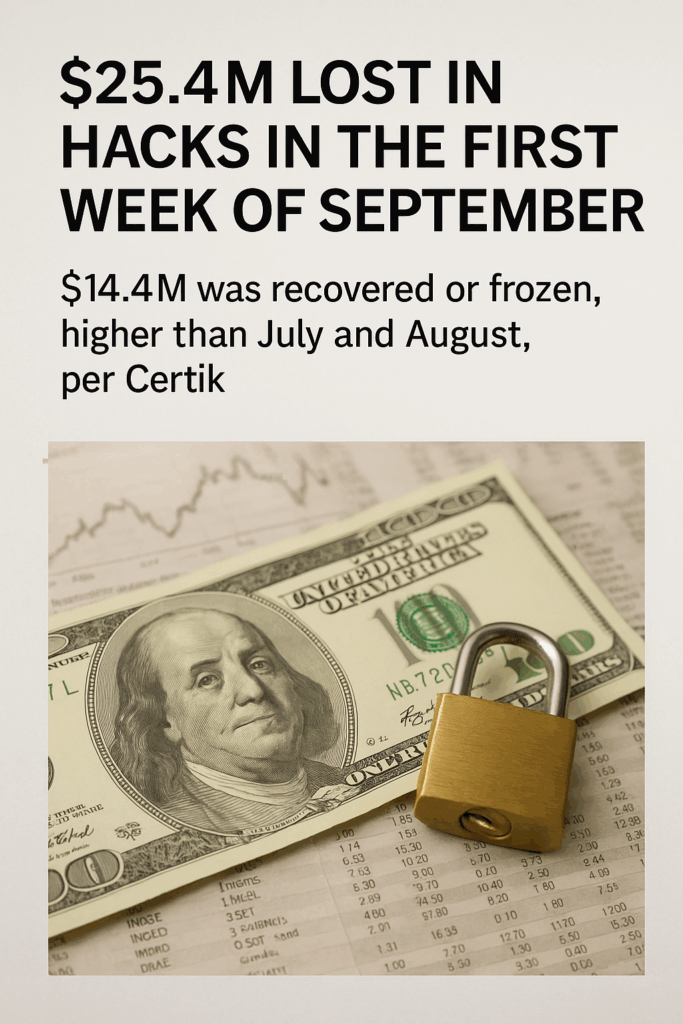Overview
CertiK — a well-known blockchain security audit and monitoring company — flagged that in the first week of September 2025, there were 6 major incidents resulting in about $25.4 million in losses due to hacks and exploits.
From that amount, approximately $14.4 million was either recovered or frozen. That’s a recovery rate of ~57 %, which is notably higher than what was observed in July and August.
After adjusting for recoveries and freezes, the net loss stood around $10.9 million.
What Makes This Significant
- Higher Recovery Rate
The fact that more than half of the stolen funds were either frozen or recovered is a positive sign — it suggests that tracking, forensic monitoring, and cooperation between platforms, law enforcement, or blockchain analytics teams are improving.
This recovery percentage is notably better than in the prior months. While exact recovery rates for July and August weren’t as high, September’s early figures show improvement. - Persistent Threat Environment
Even though the recovery is encouraging, the fact remains that ~$10.9 million is still lost in just one week. This underscores how active and effective hackers remain, especially in DeFi and smart contract spaces. - Trend Context
- In August 2025, total crypto hack losses were reported at around $173 million, continuing a rising trend in exploits.
- In the first half of 2025, cumulative losses had already reached about $2.47 billion.
- CertiK has described the situation as an “endless war” against hackers, noting that attackers only need to find one weak point in a protocol, while defenders must secure thousands of lines of code and human processes.
Possible Attack Vectors & Patterns
While the specific six incidents from September are not fully detailed, based on recent attack data the likely patterns include:
- Phishing & Social Engineering: Attackers trick users into signing malicious transactions or revealing private keys.
- Smart Contract Vulnerabilities: Bugs in DeFi protocols such as reentrancy, logic flaws, unchecked approvals, or oracle manipulation.
- Bridge / Cross-Chain Exploits: Complexity in interoperability protocols often opens doors for exploits.
- Front-End Attacks: Compromised website interfaces or injected malicious parameters.
- Wallet/Key Compromises: Poor key management practices leading to direct wallet drains.
The relatively high recovery amount suggests some incidents may have involved exchanges or custodial platforms, where funds were easier to trace and freeze.
Implications & What to Watch
- Improved Forensics and Response
The increased recovery rate shows progress in blockchain monitoring, with platforms and exchanges acting faster to freeze stolen funds. - Need for Better Pre-Emptive Security
Prevention is still the most effective defense. Many exploits succeed due to insufficient audits, rushed deployments, or lack of bug bounty programs. - Regulatory & Law Enforcement Role
Rising losses mean regulators and enforcement agencies are likely to demand stronger compliance, on-chain tracking, and faster responses from exchanges. - User Education
As phishing and social engineering remain major threats, educating users and improving wallet security design will remain crucial. - Future Trends
The rest of September will be key in determining whether the higher recovery rates represent a new trend in defensive capability or just a short-term outcome.

Conclusion
The early September hacks, totaling about $25.4M in losses, with $14.4M recovered or frozen, highlight both sides of the crypto security story. On one hand, the recovery ratio is encouraging, signaling better coordination and forensic capabilities. On the other hand, the fact that nearly $11M still vanished in a single week shows how persistent and damaging the threat landscape remains. The industry will need to continue strengthening audits, monitoring, user safety, and cross-platform cooperation if it hopes to reduce these losses sustainably.











